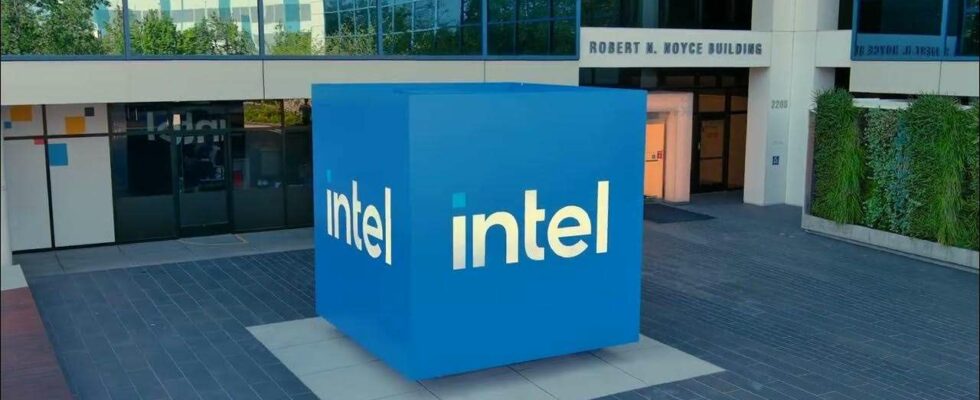Intel Corporation reported a revenue of $13.3 billion for Q3 2024, down 6% year-over-year, with a GAAP loss of $3.88 per share. The company undertook significant restructuring and asset impairment, investing $15.9 billion to strengthen its long-term profitability. Key growth areas included the Data Center and AI, while the Client Computing Group faced a decline. Future plans encompass collaborations with AMD, IBM, and AWS, alongside an independent restructuring of its Foundry Services.
—
Intel Corporation a annoncé un revenu de 13,3 milliards de dollars pour le troisième trimestre de 2024, en baisse de 6 % par rapport à l’année précédente, avec une perte de 3,88 $ par action selon les normes GAAP. L’entreprise a entrepris des restructurations importantes et une dépréciation d’actifs, investissant 15,9 milliards de dollars pour renforcer sa rentabilité à long terme. Les domaines de croissance clés comprenaient le centre de données et l’IA, tandis que le groupe informatique client a connu un déclin. Les projets futurs comprennent des collaborations avec AMD, IBM et AWS, ainsi qu’une restructuration indépendante de ses services de fonderie.
Intel Corporation has revealed its financial performance for the third quarter of 2024, reporting revenues of $13.3 billion, which reflects a 6% decrease from the same period last year. The company disclosed a GAAP (Generally Accepted Accounting Principles) earnings per share of -$3.88 and a non-GAAP earnings per share of -$0.46.
Significant restructuring and asset impairment decisions influenced Intel’s third-quarter results. The company set aside $15.9 billion for asset impairments and $2.8 billion for restructuring, as part of its broader cost management strategies aimed at trimming $10 billion in expenses by 2025.
CEO Pat Gelsinger reported that the company’s strategies for cutting costs and enhancing efficiency showed promising signs in the third quarter. Gelsinger noted that advancements in the x86 product lineup and growing interest in Intel 18A technology indicate that the cost reduction initiatives are progressing well.
CFO David Zinsner acknowledged that the restructuring expenses negatively affected profitability in the third quarter, but he maintained that these measures were crucial for securing a more robust financial foundation moving forward. During this quarter, Intel generated $4.1 billion in operating cash and paid out dividends totaling $0.5 billion per share.
The gross profit margin for Intel was recorded at 15% for the third quarter, with a non-GAAP gross profit margin of 18%. Research and development alongside general administrative expenses reached $5.4 billion, marking a 4% increase from the previous year. Intel’s operating profit saw a dramatic decline, plummeting to -68.2%, culminating in a net loss of $16.6 billion.
Breaking down revenue by product group, the Client Computing Group (CCG) witnessed a 7% yearly decline, totaling $7.3 billion. In contrast, the Data Center and AI (DCAI) segment grew by 9%, reaching $3.3 billion, while the Network and Edge (NEX) group saw a 4% increase, earning $1.5 billion. On the other hand, Intel Foundry revenue fell by 8% to $4.4 billion.
During this timeframe, Intel faced a considerable rise in restructuring and asset impairment costs, with restructuring outlays reaching $2.8 billion, of which $528 million were non-cash expenses. Additionally, Intel allocated $3.1 billion for accelerated depreciation and impairment related to specific production assets.
A goodwill impairment of $2.9 billion was noted for the Mobileye unit, along with a $9.9 billion allocation for deferred tax asset impairments in the U.S. Zinsner mentioned that the restructuring efforts are focused on enhancing the company’s long-term profitability and liquidity.
In the third quarter, Intel established the x86 Ecosystem Advisory Group in collaboration with AMD to improve partnerships with crucial technology firms in the sector. This initiative aims to streamline software development, ensure compatibility among various manufacturers, and furnish developers with standardized tools.
Furthermore, Intel is set to collaborate with IBM to deploy the new Intel Gaudi 3 AI accelerators on IBM Cloud, which aims to facilitate more affordable enterprise AI solutions and foster innovation.
Intel also entered a multi-year agreement with Amazon Web Services (AWS) to develop a custom next-generation Xeon 6 chip, based on Intel 18A technology, incorporating a new AI fabric for AWS.
Moreover, Intel has secured up to $3 billion in funding from the U.S. government’s CHIPS and Science Act for the Secure Enclave initiative, aiming to bolster reliable semiconductor manufacturing in the United States.
Another pivotal decision is Intel’s restructuring of its Intel Foundry Services (IFS) into an independent subsidiary, aiming for greater financial clarity and independence in managing relationships with external customers and suppliers.
Looking ahead to Q4 2024, Intel projects revenues between $13.3 billion and $14.3 billion. GAAP earnings per share are anticipated to show a loss of $0.24, whereas non-GAAP earnings per share are expected to be $0.12. The forecast for gross profit margin stands at 36.5% on a GAAP basis and 39.5% on a non-GAAP basis.
Intel Corporation a annoncé ses résultats financiers pour le troisième trimestre de 2024, avec des revenus de 13,3 milliards de dollars, ce qui représente une baisse de 6 % par rapport au même trimestre l’année dernière. La société a rapporté un bénéfice par action GAAP (Principes Comptables Généralement Acceptés) de -3,88 $ et un bénéfice par action non-GAAP de -0,46 $ pour cette période.
